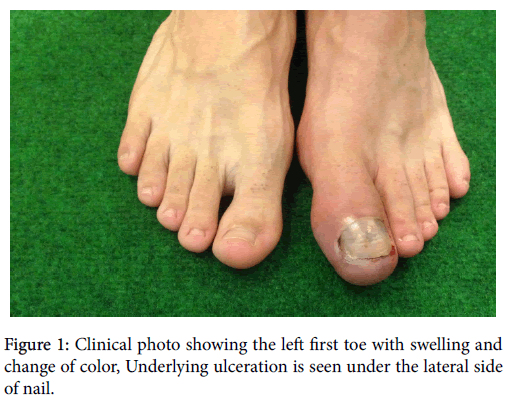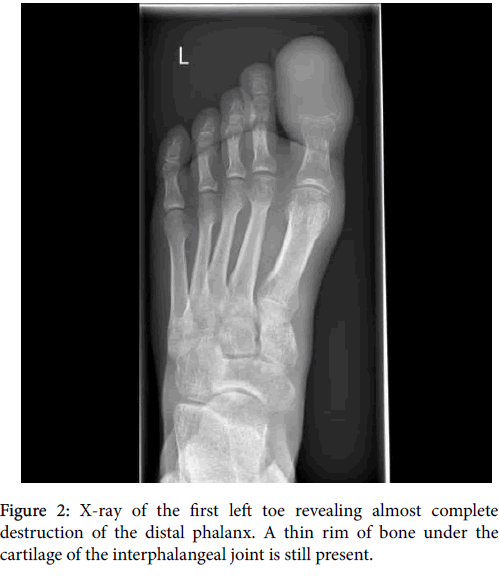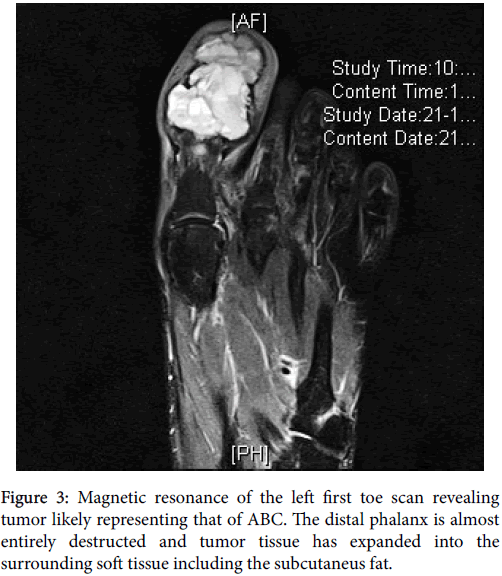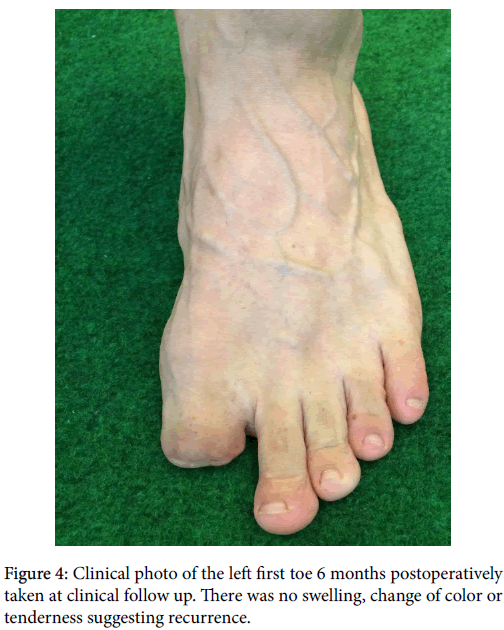Case Report Open Access
Aneurysmal Bone Cyst in a Phalanx of a Toe
Jens-Christian Vedel1* and Jens Kurt Johansen21Gentofte Hospital, Ortopædkirurgisk Afdeling, Klinik for håndkirurgi, Kildegårdsvej 28, Denmark
2Jens Kurt Johansen, Sjællands Universitets Hospital Køge, Fod-ankelsektionen, Ortopædkirurgisk afdeling, Lykkebækvej 1, 4600 Køge, Denmark
- *Corresponding Author:
- Jens-Christian Vedel
Gentofte Hospital
Ortopædkirurgisk Afdeling
Klinik for håndkirurgi, Kildegårdsvej 28, Denmark
Tel: +45 22153617
Email: vedel_jens@yahoo.dk
Received date: November 15, 2016; Accepted date: November 26, 2016; Published date: November 30, 2016
Citation: Vedel JC, Johansen JK (2016) Aneurysmal Bone Cyst in a Phalanx of a Toe. Clin Res Foot Ankle 4:219. doi:10.4172/2329-910X. 1000219
Copyright: © 2016 Vedel JC, et al. This is an open-access article distributed under the terms of the Creative Commons Attribution License, which permits unrestricted use, distribution, and reproduction in any medium, provided the original author and source are credited.
Visit for more related articles at Clinical Research on Foot & Ankle
Abstract
Aneurysmal bone cysts are a benign tumor of the bone, most commonly seen in the tibia, femur, spine and humerus. Cases of aneurysmal bone cysts in the foot, although rare, have been reported several times. To our knowledge, no case of aneurysmal bone cysts in the phalanx of a toe has been reported. We report a case of a primary benign bone tumor in the distal phalanx of the first toe in a 25-year-old male who presented with swelling and pain localized to the distal portion of his left first toe fourteen months ago. En bloc resection was performed, and subsequent microscopy revealed aneurysmal bone cyst.
Introduction
Aneurysmal bone cysts (ABC) is a rare lesion of the bone, typically arising in the tibia, femur, spine and humerus. ABCs account for approximately 1% of all bone tumors [1] and of these only 3% occur in the foot [2]. ABCs can mimic other bone tumors on imaging studies [1] and can undergo malignant transformation [3], thus making histological diagnosis mandatory.
We report, for the first time, a very rare case of an ABC localized in the distal phalanx of the left first toe in a 25-year-old male.
Case report
A 25-year-old male presented to his general practitioner with pain and swelling in his left first toe. The condition was first treated as a ligament injury. Furthermore, gout was suspected and the patient was administered pain killers for a period.
After ten months without signs of improvement the patient was seen by a rheumatologist, who performed an ultrasonic examination revealing cystic processes in the distal phalanx of the toe and cystic processes in the subcutaneous tissue surrounding the distal phalanx. Ultrasound also showed increased blood flow in the area.
The patient was then referred to the orthopaedic department. Physical examination revealed swelling of the left first toe to approximately twice the size of the patient’s right first toe (Figure 1).
Routine x-ray (Figure 2) showed almost total destruction and erosion of the distal phalanx with only a thin rim of the cortex adjacent to the interphalangeal joint left intact.
The subsequent magnetic resonance scan revealed an expansive and lytic process in the distal phalanx most likely representing an ABC (Figure 3).
As a consequence of the magnetic resonance scan most likely pointing to the diagnosis of ABC it was decided that a preoperative histological sample was not necessary.
Resection of the tumor was subsequently planned under general anaesthesia with the patient placed in supine position. Tendon insertion sites were found to be destroyed peroperatively, and both flexor and extensor tendons had retracted.
Partial amputation, including exarticulation of the interphalangeal joint, was undertaken, thus resecting the tumor en bloc.
The histological diagnosis was that of ABC. The patient’s surgical wound healed within the next two weeks without complications.
The patient was clinically examined 6 month postoperatively. The patient reported sliding forward of his foot when running because of the shortened toe. This problem was solved with a shoe insert customized for the patient by a prosthetist. Otherwise he did not have any complaints and the toe was without signs of recurrence (Figure 4).
Discussion
The presented case demonstrates that diagnosing ABCs can be challenging and prone to doctor’s delay. Once suspicion of the condition is raised, precise diagnosis can still be difficult due to ABCs resemblance to other bone tumours, especially in imaging studies [4]. Thus, most authors emphasize the need for histological examination for a precise diagnosis [1,4]. Various treatments for ABC have been suggested, and optimal treatment will differ according to the site of the lesion. Bone grafting should be considered in order to preserve function of the bone. In this case bone grafting was not possible as the cartilage bearing bone of the distal phalanx only constituted a tiny rim of bone thus necessitating exarticulation of the interphalangeal joint. Intracystic injection with an alcoholic solution is another treatment of ABC [1]. Even if this approach could have eliminated the tumor there would still be a problem with the huge lump of soft tissue without the rigidity provided by an underlying bone. Later partial amputation of the toe would most likely be necessary. Arterial embolization is a treatment modality for large tumors where complete resection is not possible without causing intolerable physical impairment [4]. Applying this method to a tumor located in an anatomical region nourished by terminal arteries could cause ischaemia of the entire toe.
In the presented case, en bloc resection was chosen. This treatment offers the lowest risk of recurrence according to a review from 2006 [1].
Conclusion
ABC in the distal phalanx of a toe has not been described until now. We emphasize that only histological examination provides a precise diagnosis and en bloc resection appears to be the safest treatment.
References
- id="Reference_Titile_Link" value="1">Cottalorda J, Bourelle S (2007) Modern concepts of primary aneurysmal bone cyst. Arch Orthop Trauma Surg127:105–114.
- id="Reference_Titile_Link" value="2">Parashari UC, Khanduri S, Upadhyay D, Bhadury S, Sinhal S (2012) Radiologic and pathologic correlation of aneurysmal bone cysts at unusual sites. J Cancer Res Ther8:103–105.
- id="Reference_Titile_Link" value="3">Brindley GW, Greene JF, Frankel LS (2005) Case reports: malignant transformation of aneurysmal bone cysts. Clin Orthop Relat Res438:282–287.
- id="Reference_Titile_Link" value="4">Iltar S, Alemdaro─?lu KB, Karalezli N, Irgit K, Caydere M et al. (2009) A case of an aneurysmal bone cyst of a metatarsal: review of the differential diagnosis and treatment options. J Foot Ankle Surg 48:74–79.
Relevant Topics
Recommended Journals
Article Tools
Article Usage
- Total views: 20550
- [From(publication date):
November-2016 - Jul 04, 2025] - Breakdown by view type
- HTML page views : 19558
- PDF downloads : 992




